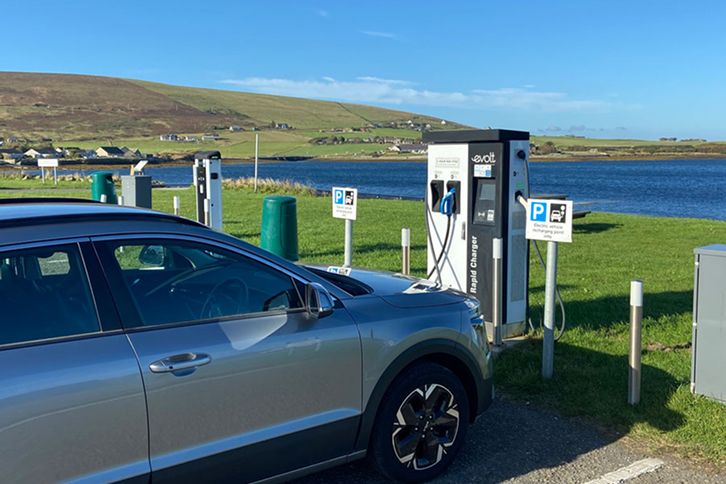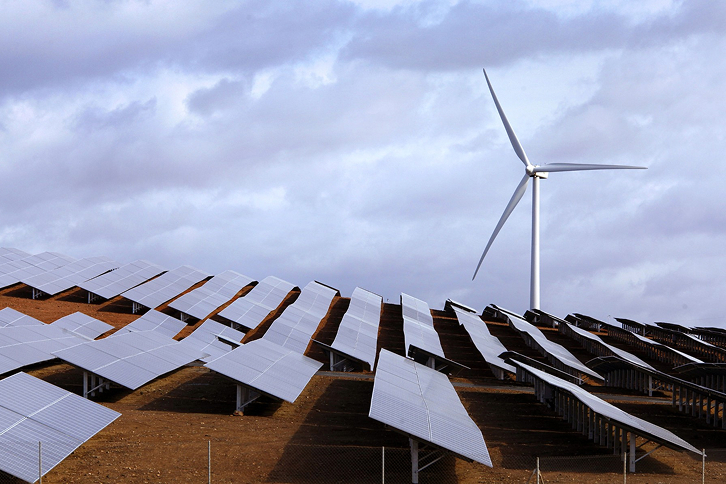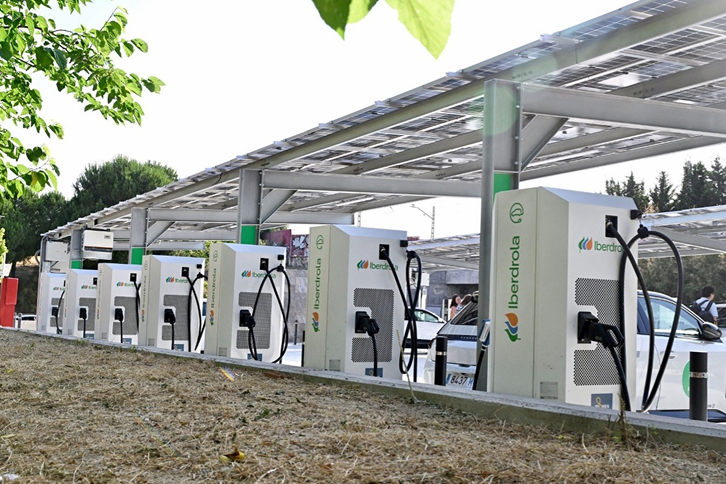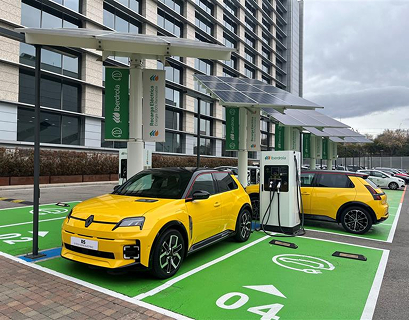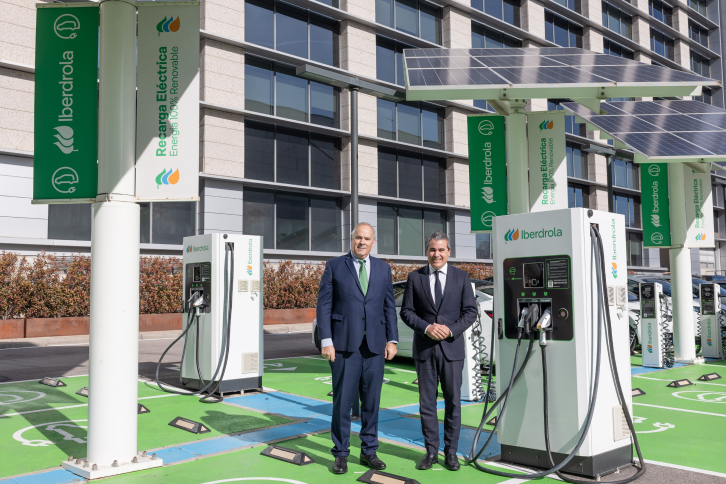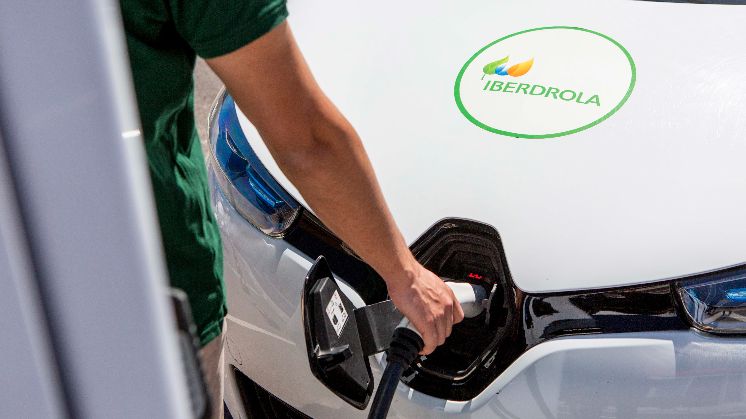
Types of electric vehicles
Complete guide to the different types of electric vehicles

September 2024

Approximately 12 minutes
As technology advances and technical improvements are made, electric vehicles are becoming more popular and more widely available. Consumers now have a wide range of options: from a hybrid car to an electric SUV, with charging speeds ranging from a few minutes to several hours. We look at the key points to consider when buying an electric vehicle: the types of cars, the difference with hybrids, how the engine works, and the range of charging and connectors.
The adoption of sustainable and green solutions is driving our energy transition process –the big change in the way we generate and consume energy. The goal is decarbonising the economy, but to achieve it we need to transform the way we travel, as transport is one of the largest energy consuming sectors and the largest emitter of greenhouse gases in the world, according to the International Energy Agency.
Electric mobility represents an unprecedented change that is transforming the way we travel. Electric vehicles have become the main alternative to make our mobility more sustainable, and are increasingly accessible thanks to a constantly evolving technology. But what types of electric vehicles are there? How do they differ and what characterises them?

Types of electric cars
In line with the increase in demand, the supply of electric vehicles has increased. Consumers now have a wide variety of brands, sizes, ranges and prices to choose from. However, one of the first decisions to be made before buying an electric vehicle is the type of vehicle desired in terms of operation and performance. These are the main options available on the market:
Electric Vehicles (EVs)
Electric vehicles, also known by the acronym EV (Electric Vehicle), are models powered by electricity as its energy source. They use electric batteries to store the energy that powers an electric motor.
Charging electric car batteries requires a connection to an electricity source, either through a household electrical outlet or at public charging stations.
This type of vehicle has gained popularity due to its higher energy efficiency, lower environmental impact and lower cost compared to traditional vehicles with internal combustion engines. In addition, their technology is constantly evolving, which means a constant improvement in range, charging times and performance. Under this umbrella, we can find many other vehicles, such as battery electric vehicles (BEV) or extended-range electric vehicles (EREV).
Hydrogen Fuel Cell Electric Vehicles (FCEVs)
Close More information
More information
Fuel Cell Electric Vehicles (FCEVs) are powered by renewable energy sources; they do not run on batteries, but on hydrogen fuel cells. This type of vehicle also has an electric motor, but instead of having a battery storing the energy, they have a fuel cell that produces electricity at the desired time. This unit, which is usually a hydrogen cell, generates electricity from a chemical reaction process called electrolysis: the hydrogen is oxidised and loses electrons which are collected to generate the electric current that makes movement possible.
FCEVs are refuelled with compressed hydrogen at hydrogen refuelling stations. Some of their advantages are that they emit only water vapour; they have shorter refuelling times compared to battery electric vehicles; and they have greater range.
- Electric car
- Hydrogen
- Internal combustion
Mild-Hybrid Electric Vehicles (MHEVs)
Close More information
More information
Micro-hybrid cars are known by different names, such as MHEVs (Mild Hybrid Electric Vehicles) or its abbreviation – mild hybrid or 48V hybrid. These vehicles have a mild hybrid system, which means they have an internal combustion engine and a small electric motor to assist the internal combustion engine. The battery is smaller than that of a conventional 48V hybrid and cannot power the vehicle independently. The electric power therefore serves to back up the internal combustion engine in acceleration phases or in less complex systems such as lighting or navigation, among others.
This type of vehicle requires fuel to move. The battery, on the other hand, is charged through energy generated during driving, especially during deceleration and braking – when the electric motor acts as a generator to recover energy and store it in the battery.
- Electric car
- Hydrogen
- Internal combustion
Extended-Range Electric Vehicles (EREVs)
Close More information
More information
Extended-Range Electric Vehicles (EREVs) combine electric vehicle (EV) and plug-in hybrid vehicle (PHEV) features. Although the propulsion power is provided by a rechargeable electric unit, they are equipped with an internal combustion motor that acts as a generator to charge the battery when it is depleted. Unlike hybrids, the combustion engine does not drive the wheels of this type of car at all.
EREVs can be charged either through a connection to an electricity source or by using petrol via the internal combustion engine. EREVs provide the efficiency and reduced emissions of an electric vehicle while overcoming the range limitations of using a combustion engine as a back-up.
- Electric car
- Hydrogen
- Internal combustion
Plug-in Hybrid Vehicle (PHEVs)
Close More information
More information
Plug-in Hybrid Electric Vehicles (PHEVs) combine an internal combustion engine with an electric motor and a battery. The main feature of these models is that both the combustion engine and the electric motor can drive the wheels of the vehicle, so that it can operate either in electric mode for a certain range of kilometres using the energy stored in the battery, or in hybrid format combining the power of the internal combustion engine with the electric motor.
The battery can be charged from an external power source or charging point and the combustion engine can also be used to charge the electric motor.
Such vehicles offer a longer range than pure battery electric vehicles and provide greater flexibility to use electricity or petrol according to the driver's needs.
- Electric car
- Hydrogen
- Internal combustion
Battery Electric Vehicles (BEVs)
Close More information
More information
These models are entirely electrically powered and use rechargeable batteries to store electricity and power the electric motor that drives the vehicle. To charge this type of vehicle, as with any electric device, it needs to be connected to an electricity source, such as a household electrical outlet or charging stations. The charging speed depends on the power of the chargers to which it can be connected, known as maximum supported power.
In addition, most models have a braking and deceleration energy recovery system, which functions as a current generator capable of "self-recharging" the battery.
These vehicles are more eco-friendly than combustion vehicles, require lower maintenance costs due to mechanical simplicity and offer a smooth and quiet driving.
- Electric car
- Hydrogen
- Internal combustion
Hybrid Electric Vehicles (HEVs)
Close More information
More information
Hybrid Electric Vehicles (HEVs) combine at least two sources of propulsion energy. They have both a conventional internal combustion engine (usually petrol or diesel) and an electric motor, and both work together to propel the vehicle. The electric motor assists the internal combustion engine at times of high demand and allows the internal combustion engine to be de-energised in order to reduce fuel consumption.
Hybrids can drive in all-electric mode, but their range is limited by small batteries. They often rely on regenerative braking and the internal combustion engine to charge the batteries and generate kinetic energy.
The use of HEVs allows for reduced emissions and improved fuel efficiency compared to traditional vehicles, especially in frequent stop-start situations.
- Electric car
- Hydrogen
- Internal combustion

We are energy in motion.
Electric vs Hybrid Cars - What's the difference
Although electric and hybrid cars share some features, they are two types of vehicles that use different technologies to propel themselves. Here are their main differences:






Primary energy source
CloseElectric car

Operates exclusively with electricity as the energy source to generate motion. It has a rechargeable battery to store the electrical energy that powers one or more electric motors.
Hybrid car

Combines an internal combustion engine with at least one electric motor and a battery. Can be powered by either petrol or electricity.
Refuelling
CloseElectric car

The vehicle can be charged by connecting it to an electricity source, such as a public charging station or a household electrical outlet.
Hybrid car

Unlike electric vehicles, hybrid vehicles can also run on petrol and are refuelled at petrol stations.
Utility of the battery
CloseElectric car

It has a battery as the only energy storage system which, together with one or more motors, generates the power needed to convert electricity into mechanical energy.
Hybrid car

The function of the battery is to assist the combustion engine and serves to improve fuel economy.
Costs
CloseElectric car

The initial price is usually higher, but this is offset by lower operating costs due to the lower price of electricity compared to petrol, and lower maintenance.
Hybrid car

Generally has a lower initial price, but maintenance and fuel costs are higher as it relies on petrol or diesel refuelling.
Emissions and energy efficiency
CloseElectric car

Produces zero exhaust emissions while driving and is quiet, making it a clean and eco-friendly option.
Hybrid car

It is more fuel efficient than the conventional vehicle, but emits pollutant gases by relying on the combustion engine.
EV charging modes
Electric vehicle batteries have four charging modes. These modes are related to the level of communication between the vehicle and the charging infrastructure and the user's control of the process. In addition, the different types of EV chargers can work with Direct Current (DC) or Alternative Current (AC).

EV connector types
Beyond charging, there are different types of connectors for electric cars on the market:
How does an electric motor work?
An electric motor converts electrical energy into motion. Its operation is based on the principle of interaction between magnetic fields and electric currents. It is composed of several main parts:





Casing
CloseThe external structure that protects and houses all the internal parts of the motor. It also provides support and serves as a mounting point for the motor.
Rotor
CloseThis is the moving part of the motor and contains coils of wire or magnets. The rotating magnetic field in the stator drags the fixed magnetic field of the rotor and causes it to rotate. Through a series of gears, this interaction allows the wheels of the electric car to rotate and thus generate motion.
Stator
CloseThis is the fixed part of the motor and contains coils of wire connected to a source of electric current. When electric current is applied to them, a magnetic field is generated inside the stator.
Shaft
CloseThis is the component that connects the rotor to the battery and the device to be driven. The rotary motion generated by the motor is transferred to the shaft to perform the desired work.
Although these are the main parts found in most electric motors, there may be additional parts depending on their specific design, features and application.
Related information
19 September 2025

















